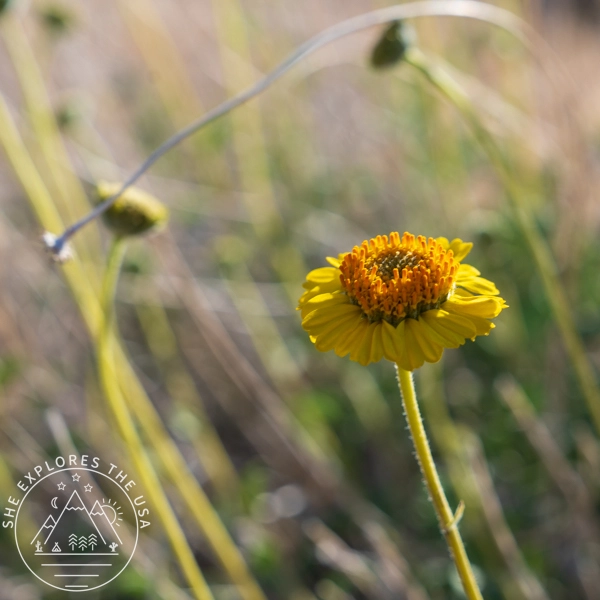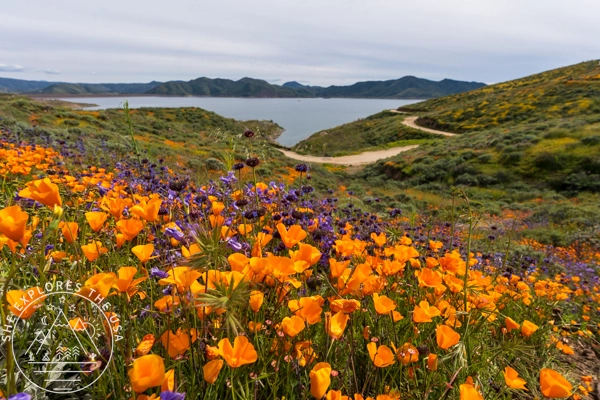Wildflowers in Joshua Tree: Where to See Them in Bloom
DISCLOSURE: This post may contain affiliate links. If you purchase after clicking one of my links, I may earn a small commission at no extra cost to you. As an Amazon Associate, I earn from qualifying purchases. For more information, see my disclaimer.
Wildflowers in Joshua Tree are one of the best things about spring in the high desert. Thanks to the park’s elevation (3,000 to 5,000 feet), bloom season here starts a little later, usually peaking from April through early June. I go to Joshua Tree often, but this spring felt especially magical. So I grabbed my camera, hit the trails, and went searching for blooms. In this guide, I’m sharing my favorite spots to see wildflowers in Joshua Tree National Park, along with some tips and photos from the field.
- Etiquette for Enjoying Wildflowers in Joshua Tree
- Product Recommendation
- Best Wildflower Spots on Park Boulevard
- Wildflowers Along Barker Dam Road
- Wildflowers on Boy Scout Trail
- Skull Rock Wildflowers in Bloom
- Where else can we find wildflowers in Joshua Tree National Park?
- FAQ About Wildflowers in Joshua Tree
- When is the best time to see wildflowers in Joshua Tree?
- Where are the best spots to see wildflowers in Joshua Tree?
- Can I pick wildflowers in Joshua Tree National Park?
- What kind of wildflowers can I expect to see?
- How long do wildflowers last in Joshua Tree?
- What should I bring on a wildflower hike?
- Is there a best time of day to see wildflowers?
- Final Thoughts on Wildflowers in Joshua Tree
Etiquette for Enjoying Wildflowers in Joshua Tree
The Leave No Trace principles are a set of guidelines designed to help minimize the impact of human activities on the wilderness.
- Plan ahead and prepare
- Travel and camp on durable surfaces
- dispose of waste properly
- Leave what you find
- minimize campfire impacts
- respect wildlife
- Be considerate of others
With that in mind, when visiting any areas where wildflowers are present, please remember the best wildflowers etiquette: do not step on wildflowers, and do not pick wildflowers. Only walk on designated trails, and take only photos and memories home with you! Please leave the desert as you find it, so that our future generations can enjoy it too. THANK YOU!
7 Leave No Trace Principles: How to Teach Kids
Mastering the seven Leave No Trace principles is essential for any outdoor enthusiast. Developed by the […]…
Product Recommendation
Enhance your Joshua Tree wildflowers adventure with these essential products:
- Compact Binoculars for Adults and Kids: These lightweight, high-powered binoculars are perfect for spotting wildflowers and wildlife in Joshua Tree. With 12x magnification and a 25mm lens, they offer a wide field of view, 273 feet at 1,000 yards. The image quality is clear and lifelike thanks to the FMC coating and BAK4 prism. The adjustable eye cups make them comfortable for both eyeglass wearers and non-wearers. They’re also waterproof, durable, and easy to carry, with a rubber grip that feels solid in hand. Great for hiking, birdwatching, or just taking in the view, and they work well for both adults and kids.
- Mojave Desert Wildflowers: This field guide dives deep into the plants of the Mojave Desert, from Joshua tree woodlands to dry alkali flats. With full-color photos and easy-to-read charts, it helps you identify 300 common species by color and plant family. Whether you’re new to wildflower hunting or already hooked, this updated edition offers bloom info, fun facts, and plenty of visuals to bring your desert hikes to life.
- Wildflowers of California Field Guide: Looking for wildflowers beyond Joshua Tree? This guide by Laird R. Blackwell shows you what’s blooming each month across California. It includes over 650 photos, plus trail and driving directions to help you find the flowers. It’s great for road trips, casual hikers, or anyone who wants to learn more about the state’s native plants.
- Neutrogena Ultra Sheer Dry-Touch Sunscreen: If you’re heading into the desert, don’t skip the sunscreen. This broad-spectrum SPF 70 lotion is lightweight, non-greasy, and water-resistant, perfect for sweaty hikes and long sunny days. It absorbs fast and doesn’t feel sticky, so you can focus on the flowers, not your skin.
Best Wildflower Spots on Park Boulevard
Park Boulevard is one of the main roads through Joshua Tree National Park. This scenic drive is 34.6 miles long and connects the West entrance to the North entrance, or the other way around.
The West entrance is the most popular, which often means long lines and traffic. If you want a smoother experience, I recommend entering from the North entrance and making your way west.
Along the drive, you’ll pass several of the park’s most popular hiking trails, including Boy Scout Trail, Hidden Valley, Ryan Mountain, and Skull Rock.
Right now, wildflowers are blooming along many stretches of this road. The most eye-catching are the apricot mallows, known for their bright orange petals.
Wildflowers Along Barker Dam Road
If you’re headed to Barker Dam, don’t forget to look around as you drive along Barker Dam Road. There are many places available to pull over and enjoy the wildflowers. I found these woolly marigolds, apricot mallows, pincushions, and brittlebush there!




Wildflowers on Boy Scout Trail
Boy Scout Trail is a well-loved hike in Joshua Tree. It stretches 7.8 miles one way, from the Boy Scout trailhead to Indian Cove. You can park at either end, depending on your plans. If you’re backpacking, I have a separate post that explains the new rules in the park.
On this visit, I started at the Boy Scout parking lot and hiked about 7 miles round trip. Honestly, you don’t need to go far to feel the magic. Even walking just one mile from the trailhead gives you a real sense of the desert’s beauty.
The trail was peaceful and easy to follow. Wildflowers and cacti were blooming everywhere, with the San Bernardino Mountains in the distance.
Some of the desert plants I saw included Canterbury bells, silver cholla, Heermann’s buckwheat, New Mexico thistle, beavertail cactus, and desert pincushions.








Skull Rock Wildflowers in Bloom
Saving the best for last, the most colorful wildflowers I saw in Joshua Tree were on Skull Rock Trail. This loop is 1.8 miles long. It starts at the Skull Rock parking area on Park Boulevard and connects to the Jumbo Rocks campground.
If you’re visiting on a hot day, good news. Many of the wildflowers are right by the parking lot. You don’t need to hike far. Most blooms are just steps from your car. It’s the perfect spot for a short, scenic stroll.
Here are some of the flowers I spotted: apricot mallow, mule fat, brittlebush, Mojave aster, beavertail cactus, paper bag bush, and hedgehog cactus.










Where else can we find wildflowers in Joshua Tree National Park?
You can also find wildflowers in Joshua Tree beyond the main spots I mentioned. Look along trails like Hidden Valley, Indian Cove, Twin Tanks, and Black Rock Canyon, especially if you’re camping nearby. Blooms have also been spotted around Juniper Flats and along the road just north of the Cholla Cactus Garden.
The desert can surprise you. If you’re heading out on a wildflower hunt this spring, stay alert. Keep your eyes open and your camera ready, flowers can show up when you least expect them.
Wildflowers in Joshua Tree don’t last long. Their timing depends on rainfall and temperature. But even a short spring visit can be magical. Maybe it’s a burst of apricot mallow or a hillside of brittlebush glowing in golden light.
Diamond Valley Lake: How to Enjoy The Wildflowers
Are you seeking a fun family adventure in Southern California? With all the rain we got this year, flowers are…
Anza Borrego Wildflowers Guide: Where To See Them
Are you looking for day trip ideas from San Diego? Following a rainy winter in Southern California, desert […]…
FAQ About Wildflowers in Joshua Tree
When is the best time to see wildflowers in Joshua Tree?
Wildflower season usually peaks from April through early June. Thanks to the park’s elevation (3,000 to 5,000 feet), blooms start later here than in lower deserts. Spring visits during these months give you the best chance to catch the full display.
Where are the best spots to see wildflowers in Joshua Tree?
Some top spots include Park Boulevard, Barker Dam Road, Boy Scout Trail, and Skull Rock Trail. But don’t overlook places like Hidden Valley, Indian Cove, Twin Tanks, Black Rock Canyon, Juniper Flats, and the road north of the Cholla Cactus Garden.
Can I pick wildflowers in Joshua Tree National Park?
No. Please don’t pick or disturb wildflowers. Joshua Tree’s ecosystem is delicate, and picking flowers can harm the plants and spoil the experience for others. Stick to designated trails and leave only footprints and photos behind.
What kind of wildflowers can I expect to see?
You might spot apricot mallows, mule fat, brittlebush, Mojave asters, beavertail cactus, paper bag bush, hedgehog cactus, Canterbury bells, silver cholla, Heermann’s buckwheat, New Mexico thistle, and many more, depending on the area and timing.
How long do wildflowers last in Joshua Tree?
Wildflowers in Joshua Tree come and go quickly. Their blooming depends heavily on recent rainfall and temperature. Some years bring spectacular blooms; others are more muted. But even a short visit in spring can be magical.
What should I bring on a wildflower hike?
Pack water, sun protection like a broad-spectrum sunscreen, a camera, and comfortable shoes. Binoculars can be handy for spotting distant blooms and wildlife, especially on longer hikes.
Is there a best time of day to see wildflowers?
Early morning or late afternoon light is best for both viewing and photographing wildflowers. The softer light brings out colors beautifully and keeps you cooler during desert hikes.
Final Thoughts on Wildflowers in Joshua Tree
Wildflowers in Joshua Tree are a fleeting, beautiful reminder of how life in the desert quietly blooms against all odds. They don’t last long, and their timing depends on the rain and the weather, making each season unique and unpredictable. That’s part of the magic, showing up with an open heart and curious eyes to catch whatever moments the desert gifts you.
Whether it’s a small patch of apricot mallows brightening a rocky slope or a hillside glowing with brittlebush under golden light, these blooms invite us to slow down and truly notice the little wonders around us.
If you’re planning a trip, take your time. Walk gently, tread lightly, and be present. Joshua Tree’s wildflowers aren’t just a visual treat; they’re a quiet celebration of resilience and beauty in one of the toughest landscapes.
Happy wildflower hunting, and may your desert adventures fill you with awe and inspiration.
Post originally published on May 17, 2023, and last updated on December 7, 2025.















